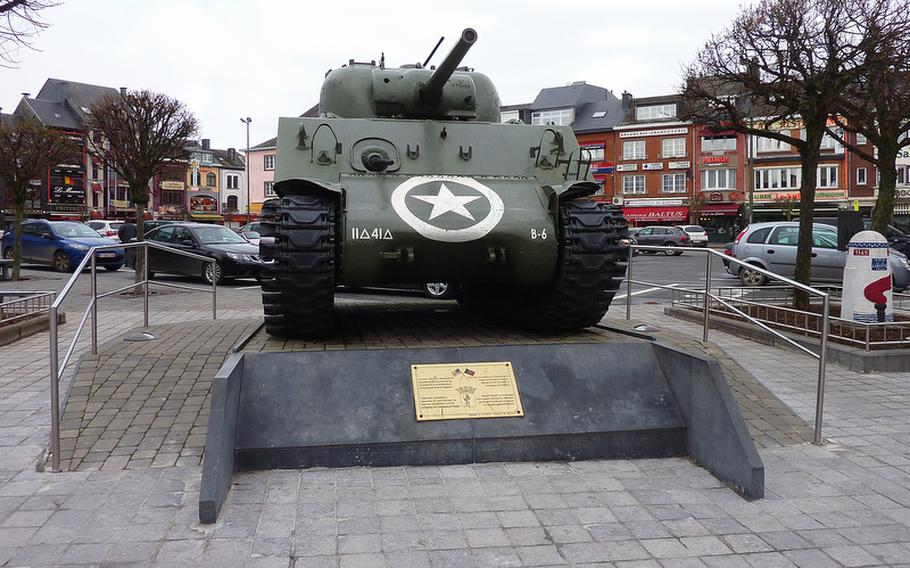
The Sherman tank on Bastogne's McAuliffe Square is a popular monument in the Belgian town. The tank belonged to the 11th Armored Division and was brought to a stop in the village of Renuamont on Dec. 30, 1944, after a German attack. Its crew was captured by the Germans and taken to a prisoner camp. (Michael Abrams/Stars and Stripes)
They speak French here, but if there is an official second language in this town of 15,000, it would have to be “American.”
Between all the stars and stripes flags, numerous monuments to old military legends and a massive memorial to the fallen, there is no escaping the U.S. military’s stamp on the town of Bastogne, Belgium. And that is for good reason.
It was in and around Bastogne where one of the biggest and bloodiest World War II battles took place: Battle of the Bulge. Today, the town’s whole identity is wrapped up in the lore of that battle and honoring the sacrifices of the soldiers who fought to save Bastogne from falling into Nazi hands.
For history buffs and anyone simply looking to pay homage to the troops who fought there nearly 70 years ago, Bastogne should be a can’t-miss destination while stationed in Europe. And if you have a hole in your weekend travel itinerary this month, now could be a great time to pay a visit to Bastogne, where on Dec. 15, there will be a historic walk that retraces key moments during the defense of Bastogne.
The walk, which marks the 68th anniversary of the siege on Bastogne, starts at 7 a.m. No preregistration is required to attend, according to the U.S. Army Garrison Benelux, which serves as a co-sponsor of the event. The weekend also will include a color guard parade through town and a host of other special exhibitions.
Bastogne, which is about 150 miles northeast of Kaiserslautern, Germany, is situated along Belgium’s hilly border with Luxembourg, a region where many historic World War II battles took place. The city itself is small, but charming. The main street features a host of shops and inviting restaurants, many of which play up the town’s connection to its key role during the war. Yet for all of Bastogne’s small-town appeal, make no mistake about the main attraction: its special place in World War II history.
During the Battle of the Bulge, the siege on Bastogne was a key point in the fight. Surrounded by Germans, the town was under the protection of the 101st Airborne Division. Outgunned and outnumbered, U.S. Army Brig. Gen. Anthony C. McAuliffe received a letter from German commanders Dec. 22, 1944, requesting the surrender of all American troops under his command. McAuliffe responded with the now legendary retort: “Nuts!”
Today, there’s a restaurant called La Nut’s in Bastogne’s town square, where a monument stands in McAuliffe’s honor.
The town is filled with all sorts of war memorabilia: An old Sherman tank is prominently placed downtown, around the corner from a stone monument to Gen. George S. Patton. There also are various war-related museums, including an exhibition on the Battle of Bastogne, called “I was 20 in ’45 in Bastogne.”
But if there is one can’t-miss stop during any visit to Bastogne, it is the towering monument dedicated to those who fought to defend Bastogne. The Mardasson memorial, which opened in 1950 on the outskirts of the town, is a big star-shaped structure with five points. The story of the battle is engraved on the monument’s walls, and it lists the units that took part in the fight, also known as the Ardennes Offensive.
A steep, spiral staircase leads you to the top, where you can take in the hilly view and contemplate all the fighting that took place during the siege of Bastogne. During the entire battle, about 19,000 U.S. soldiers died, 47,500 were wounded and more than 23,000 were missing, according to the Defense Department. The month-long struggle stretched from December 1944 to January 1945 and was one of the bloodiest battles of the war for the Americans. Their victory served as something of a final death knell for the German military.
Next to the Mardasson memorial, a new Bastogne War Museum is under construction and is slated to open this spring.
But whether you go now or wait for the grand opening of the war museum, you can’t go wrong in Bastogne, where a visit means walking in the footsteps of the 101st Airborne Division.